On the origins of dark matter
More on:
Stephen "Current accounts almost always don't matter" Jen is intrigued by Ricardo Hausmann and Fredrico Struzenegger's discovery of dark matter. Lots of others are too. Michael Mandel for one. See Claus Vistesen for a wrap-up of the initial flurry.
Jen's and Mandel's interest is no surprise. Dark matter supports Jen's over-arching dollar bullishness in the face of large deficits, even if it doesn't generate the $1 trillion or so in cold hard cash the US needs to finance its (expected) 2006 current account deficit. Though in fairness, Jen currently expects the dollar to weaken against Asia -- just for cyclical reasons, not structural ones like the US current account deficit. And the discovery of dark matter supports Mandel's belief that the current account deficit is dated concept -- rising external liabilities are fine so long domestic assets are rising. Dark matter suggests that the United States' (net) external liabilities, correctly measured, aren't really rising.
I digress. This post is about the origins of dark matter, not its adoption by those who think current account don't matter - or at least do not matter quite as much as I do. I have a bit of skin in this game: Hausmann and Sturzenegger frame their argument (which has now been updated) in part as a response to the arguments Dr. Roubini and I have made in the past.
So my apologies for a lengthy, data-rich, link-heavy post that tries to synthesize a lot of material. The Lex column of the FT covers some of the same ground in far fewer words.
Both Higgins, Klitgaard and Tille of the New York Federal Reserve and the CBO also have examined why the US earns more on its overseas assets than its pays on its external assets. They, like me, just didn't have the genius required to spin the fact that foreign investment in the US earns next to nothing (judging from the balance of payments data) as a good thing. Or the temerity to argue that the US can finance its current account deficit by borrowing against the imputed assets ("dark matter") created by low foreign returns on investments in the US!
Dark matter, as defined by Hausmann and Sturzenegger, is the gap between the assets implied by the fact that the US receives more on its international investments than it pays on its external debt (the investment income line in the balance of payments is positive, or at least was) and the United States' formal debt position.
In 2004, according to Hausmann and Sturzenegger, the US got $30 billion more on its overseas investments than it paid on its external debts, which implies $600 billion of assets (with a 5% return). Yet formally the US had $2.5 trillion in (net) external debt, which implies (with a 5% return) net payments of $125 billion. Voila. $3.1 trillion in dark matter.
Actually, the revised data on investment income suggests the gap was a bit bigger - more like $35 billion. Hausmann and Sturzenegger may have underestimated the stock of dark matter ever so slightly. No matter.
In 2005, the income line will probably be slightly negative, at least if I am right about the fourth quarter. But in the grand scheme of things, it will remain pretty close to zero. The net investment position of the US also will deteriorate, to north of $3 trillion. Let's say $3.2 trillion. I am assuming about $100 billion in capital gains on US equities abroad. That implies the US should have an income deficit of $160 billion. It didn't. Or in Hausmann and Sturzenegger's terms, the amount of dark matter on the US balance sheet rose slightly, to $3.2 trillion.
Stubborn long-term dollar bears - at least those who have looked closely that the balance of payments data - were quite aware that the US does not (yet) make net payments of interest to the world. For that matter, we stubborn bears also have noted the fact that the US net international investment has deteriorated far less than would be expected by large ongoing current account deficits.
We just are not convinced that the current, positive investment income balance is:
- Likely to last. US interest rates are not going to stay as low as they were in 2002, 2003 and 2004. And foreigners hold a decent chunk of US debt, particularly US Treasuries. Payments on US debt are rising. See Menzie Chinn.
- Real, rather than an artifact of tax arbitrage and transfer pricing. US firms have an incentive to report profits in low tax countries (at least if they finance themselves with equity, not debt, see the CBO). European firms seem to have an incentive to minimize their reported US profits. I'll put it this way. US firms like to report their profits in low-tax European countries (Ireland, among others). And European firms seem to like to report their profits from their US operations in low-tax European countries too.
I want to take each point in turn. But first, a few basic facts.
At the end of 2004, the US had $10 trillion in external assets, and in 2004 it received 376.5 billion on those assets. It had $12.5 trillion in liabilities, and paid $$340 billion on it. That works out to an implied rate of return of 3.8% on US overseas assets, and an return of 2.7% on foreign assets in the US. Store that away, and remember, that difference is in dollar returns - it doesn't account for exchange rate changes.
In 2005, both US assets and US liabilities will increase. Assets (including valuation changes) could rise to roughly $10.6 trillion, and liabilities to $13.9 trillion. I estimate that the US is likely to get about $455 billion on its assets, and pay $460 billion on its liabilities. If , that works out to a return of 4.3% on US assets, and payments of 3.3% on US liabilities.
Let's disaggregate the data on assets and liabilities to better match the categories that appear in the current account data. The dollar value of US equity investment abroad has surged since 2002, so the US now has more equity investment - including FDI - abroad than foreigners have equity investment in the US. American portfolio holdings of foreign stock exceed foreign holdings of US stock.
However, the positive net US equity position is offset by a big net debt position. By my calculations, the US has lent about $4.15 trillion to the world at the end of 2004, but the world has lent $7.9 trillion to the US. This shows up clearly if you look at the US net investment position, disaggregated by different categories. The recent rise in the value of US equity investment abroad has been offset - as we know - by a rise in private holdings of US debt securities (net of US holdings of foreign securities), and by a rise in official claims on the US (net of US reserves and other foreign assets of the US government).
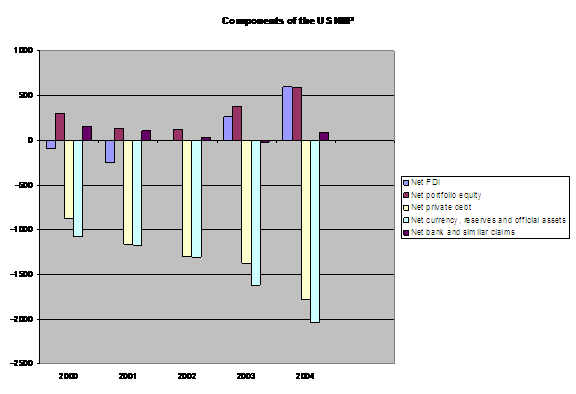
According to the available evidence, the US generally not only borrows in the dollars, but also generally lends to the rest of the world in dollars. US holdings of euro, yen and even high-yielding Brazilian real denominate bonds are relatively small. That means the net US debt position doesn't vary with currency moves, and the US basically gets a dollar interest rate on the money it has lent to the rest of the world.
It also means that we can dismiss one of the explanations Hausmann and Sturzenegger put forward for dark matter, namely the United States capacity to borrow abroad cheaply to finance the purchase of high-yielding emerging market debt.
That happens, but not on a big scale. US has lent about $4.15 trillion to the world. The EMBI - the leading index of dollar-denominated emerging market bonds - has a market cap $290 billion, and not all those bonds are held by Americans. The disaggregated survey data from the US Treasury tell the same story. The US holds lots of British, Canadian, Japanese, European and Cayman bonds - and not so many Mexican and Brazilian bonds. The Cayman bonds are presumably issued by US firms that have moved offshore.
That brings me to a key point. Dark matter doesn't stem from particularly high reported returns on US investment abroad. It stems from unusually low returns on foreign investment in the US. Steve Kyle is right: dark matter looks more like dark anti-matter.
Pictures often can tell a story better than words.
Dark Matter stems in part from low US policy rates
I have summed up "government payments" and "other payments" recorded in the income line of the US current account. And compared what the US pays on its debts (and any dividends paid to foreign portfolio investment in US stocks) to what the US gets on its lending to the rest of the world (and any dividends the US gets on its investment in foreign stocks).
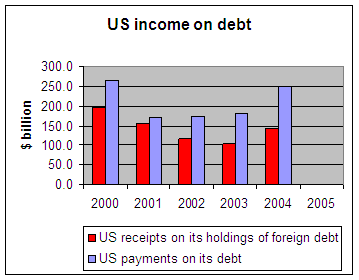
A couple of things stand out. First, in 2004 the US paid out a bit LESS than it paid out in 2000. Thank you Alan Greenspan. Rising debt was offset by falling US rates.
The aggregate payments the US receives on the money it loans out to the rest of the world (setting 2001 aside) generally have moved in line with US payments. Indeed, the relative returns on US lending to the world and foreign lending to the US are quite similar. That is consistent with the data showing that most US lending to foreigners is in dollars (or with foreign rates moving in line with US rates).
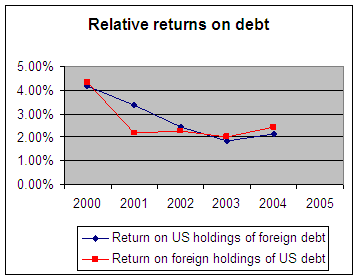
One point of clarification. This data includes payments and holdings on "portfolio" equity, largely because stripping dividends out of the data is more trouble than its worth. To see the data with dividends on portfolio equity merged with payments on FDI, see Higgins, Klitgaard and Tille.
The problem going forward.? Simple. US rates are rising. So too are US interest payments. See Robert Scott of the EPI. That's only fair. Foreign investors have accepted very low yields for a while. They earned their reward ....
Given that the US tends to both borrow from and lent to the rest of the world in dollars - and given that it has borrowed far more than it has lent - rising dollar interest rates tend to increase the (net) US interest bill - and reduce the total stock of dark matter.
Dark matter stems for low returns on foreign direct investment in the US
That brings me to the second source of "dark" matter -- the gap between the return that foreign direct investors report on their US income and the return that US firms report on their direct investment abroad. In 2004, the US received $128 billion more than it paid out.
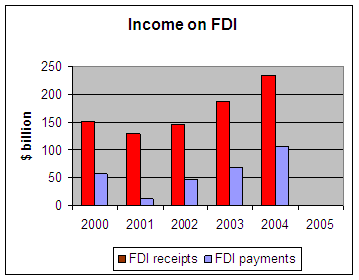
The US has effectively financed some high yielding investment abroad with low-yielding US debt. But that is not the primary source of dark matter. The market value of US direct investment abroad only exceeded the market value of foreign investment in the US by $600 billion -- not nearly enough to generate an income surplus of $128 billion.
The real source of dark matter is that a dollar of US investment abroad yields a far higher return than a dollar of foreign investment in the US. Look at this graph, which shows the reported return on US FDI abroad and the reported return on foreign investment in the US.

There returns were calculated relative the market value of foreign direct investment, but the story doesn't change much if you use book value (current cost in the balance of payments data). The average returns on US investment abroad over the past five years rises from 6.5% to 8.9%; the average return on foreign investment in the US rises from 2.3% to 3.7%. The discrepancy remains.
The gap doesn't stem from the fact that US firms tend to invest in particularly risky countries, like say Bolivia. Most US foreign direct investment is in Europe, Canada and Japan. And most foreign direct investment in the US comes from Europe, Canada and Japan. Certainly not from China. Dark matter is a US-European thing, not a US-emerging markets thing - even if it was discovered by two distinguished Latin American economist.
The second key point: the reported return on foreign direct investment in the US have not been all that spectacular, to say the least. Actual returns averaged 2.3% between 2000 and 2004. So much for the argument that the US is the world's greatest place to invest.
The fact that dark matter comes from the incredibly low reported return on foreign direct investment in the US, not from great US returns on its overseas investment also casts doubt on Hausmann and Sturzenegger's claim that dark matter comes from superior US know-how.
You know the story. Disney takes out a low interest loan to build Eurodisney. But then its skill turns a field outside Paris into the Magic kingdom, and a money machine. The profits on Eurodisney lead the price of Disney's US stock to soar. But that doesn't get captured in the formal measurement of the net international investment position.
I actually am not so sure about that. Technically, I think the loan would appear as a foreign liability of a US resident (the Disney corporation), and Disneyland Paris as the offsetting asset. The payments on the loan should appear in the income balance of the US (as US debt payments). And Disneyland Paris' profits should appear in the income balance too, as the profits on US investment abroad. Call it the gains of intermediation - Disney issues low yielding debt abroad to build a high-yielding asset abroad. So if everything is valued correctly and measured correctly, the large profits Disney earns abroad that support the high valuation of Disney's US stock should appear in the balance payments. That of course is a big if.
But there is another reason why Hausmann and Sturzenegger's story doesn't make all that much sense to me. European firms know a thing or two about luxury retailing. LVMH. Cheap chic too. Zara and H&M. French champagne is just better - that has to generate some dark matter. German firms have a reputation for top of the line engineering. BMW. Japanese firms for quality and fuel-efficiency. Toyota. Not all corporate know-how is concentrated in the US.
Hat tips: Old Vet, Steve Kyle, PGL and Kash over at Angry Bear.
So all things being equal, one would expect some of the same factors that generate dark matter for the US to work in reverse. Toyota and BMW take out dollar loans to finance the construction of US assembly plants, and then make Eurodisney sized profits on their reputation for quality. Hausmann and Sturzenegger's argument only works if say Toyota and BMW really earn very little on their US operations, while Ford and GM earn a lot in Europe. Somehow, I doubt it.
Ok, in some sectors, US firms can exploit de facto monopolies (Microsoft for PC operating systems), duopolies (Intel and AMD for CPUs), unique know-how (Google's skill matching eyeballs to ads) or skill using IT to manage inventories in big boxes (Walmart). Maybe high US margins in these sector's offset juicy foreign margins in sectors where US firms are not world beaters. Maybe.
There are other potential explanations for low profits on investment in the US. In recession years -or years when the euro and yen are unusually strong -- foreign firms operating in the US may temporarily accept low margins to maintain market share. That may explain why foreign firms did so badly in 2002 and even 2003. And foreign firms may have overbid for no profit US companies at the height of the tech bubble. But established European firms should have been doing very well in 2000, when the US economy was booming and the euro and yen are weak.
It seems strange that, in good times as well as bad, the reported return on foreign direct investment in the US is quite low. So low that most foreign firms would have been better off just putting their money in Treasuries.
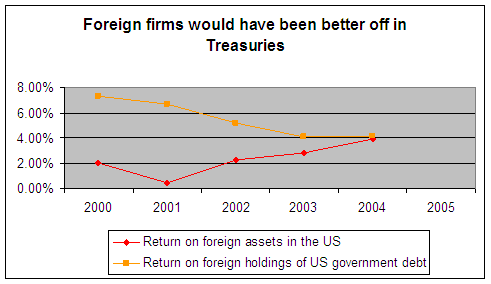
Note. The reported return on holding US debt in 2000 and 2001 may seem a bit high, but my numbers parallel those of William Cline of the IIE. No funny business.
What else might explain the difference between US profits abroad and foreign profits in the US, other than superior US know-how?
Easy. Tax avoidance and transfer pricing.
The US theoretically taxes an American firm's global profits, not just the profits from its US operations. In practice, however, US corporate taxes can be avoided so long as a US firm doesn't formally repatriate its profits. Or, for that matter, if the company waits until the US passes a tax holiday to encourage repatriation.
The EU doesn't have a harmonized corporate tax. That means US firms -- at least those that finance themselves with equity not debt, hat tip Menzie Chinn -- have an incentive to show their European profits in low tax jurisdictions in Europe. Perhaps some of their global profits too.
An example: Microsoft, for some reason, books lots of profits in Ireland. Glenn Simpson in the November Wall Street Journal:
The four-year-old subsidiary, Round Island One Ltd., has a thin roster of employees but controls more than $16 billion in Microsoft assets. Virtually unknown in Ireland, on paper it has quickly become one of the country's biggest companies, with gross profits of nearly $9 billion in 2004.
Ireland's citizens may not have heard of Round Island One, but they benefit greatly from its presence. Last year the unit handed the government of this small country of four million citizens more than $300 million in taxes.
The citizens of other nations where Microsoft sells its products are less fortunate. Round Island One provides a structure for Microsoft to radically reduce its corporate taxes in much of Europe, and similarly shields billions of dollars from U.S. taxation.
No Wall Street Journal subscription? This Irish blog covers the key points of Simpson's article.
Another example: Ever wonder why Pfizer's effective US tax rate was 8.2% in 2003 -- not 35%? Ever wonder why Pfizer makes Lipitor in Ireland? Finfacts/ Ireland Business News (emphasis added)
In October 2004, the Financial Times said that from 1994 to 2003, foreign profits of the six largest US pharmaceuticals companies went from 38 per cent of their overall income to more than 65 per cent. At the same time, the taxes paid on those profits fell from a rate of 31 per cent to 17.5 per cent, just half the US corporate tax rate.
In the case of the drug companies, the growing share of profits booked abroad - most of it in low-tax jurisdictions - does not reflect any significant shift in where those companies do business. Even as their overseas share of profits nearly doubled over the past decade, their overseas sales grew from just 40 to 43 per cent.
The net result: European firms AND American firms both want to show profits from their global operations outside the US, whether in low-tax European jurisdictions or the Caribbean.
That doesn't necessarily mean the US current account deficit is mismeasured: as Philip Lane noted in the comments of an earlier post, firms can increase their "overseas" profits is by understating the value of their exports to their subsidiaries abroad. That just shifts US external revenues from the export line to the income line of the balance of payments.
I don't have proof that tax arbitrage explains the large gap in reported rates of return. It was easier to find information of US firms avoiding US (and other) taxes by routing US profits through Europe than the strategies that European firms use to avoid US (and other) taxes. To paraphrase a Deutsche Bank research report, it is hard to find empirical support for the argument that tax arbitrage accounts for the gap in returns, but easy to find anecdotal evidence. In this case, I believe the anecdotes.
Remember, lots of balance of payment data ultimately comes from tax data, of one kind (customs) or another (corporate income tax returns).
Sum up the evidence, and my bottom line is simple. I suspect a lot of dark matter has its origins in what some have called one of the dark sides of globalization. Corporate tax arbitrage.
More on:
 Online Store
Online Store
